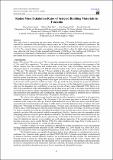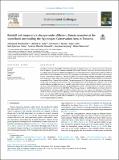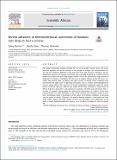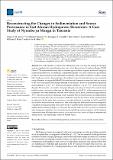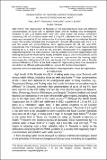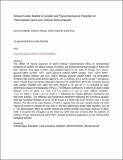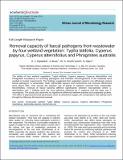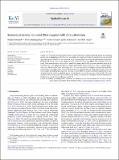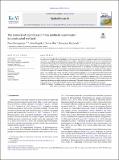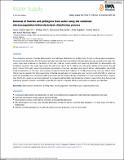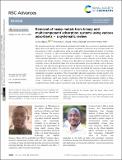Browsing Research Articles [MEWES] by Title
Now showing items 425-444 of 570
-
Radioactivity distribution in soil, rock and tailings at the Geita Gold Mine in Tanzania
(Elsevier B. V., 2025-04-30)This study evaluated the activity concentrations of natural radionuclides in soil, waste rocks and tailings from the Geita gold mining site in Tanzania using high-resolution gamma spectroscopy. A total of 41 samples: 31 ... -
Radon Mass Exhalation Rates of Selected Building Materials in Tanzania
(Journal of Environment and Earth Science, 2015)This study aimed at determining the mass radon exhalation rate of Tanzania Portland cements and their raw materials for assessment of the radiological hazards due to use of those materials in residential construction. ... -
Rainfall and temperature changes under different climate scenarios at the watersheds surrounding the Ngorongoro Conservation Area in Tanzania
(Elsevier, 2022-04)Considering the high vulnerability of Northern Tanzania to climate change, an in-depth assessment at the local scale is required urgently to formulate sustainable adaptations measures. Therefore, this study analyzed the ... -
Rare earth elements and uranium in Minjingu phosphate fertilizer products: Plant food for thought
(ELSEVIER, 2024-08-01)Minjingu phosphate ore is Tanzania's sole domestic supply of phosphorus (P). The ore contains medium to high concentrations of naturally occurring P2O5 (20–35 %) and relevant concentrations of uranium and rare earth elements ... -
Re-introducing Politics in African Farmer-Led Irrigation Development: Introduction to a Special Issue
(Water Alternatives, 2019-02)This introduction is a reflexive piece on the notion of farmer-led irrigation development and its politics. It highlights the way the varied contributions to the Special Issue support a shared perspective on farmerled ... -
Recent advances in thermochemical conversion of biomass into drop-in fuel:a review
(Elsevier, 2022)The global evolutional changes towards the use of renewable energy sources for trans- portation purposes are on the increase in an attempt to mitigate the environmental haz- ard and the proposed depletion associated with ... -
Recent and sustainable advances in phytoremediation of heavy metals from wastewater using aquatic plant species: Green approach
(Elsevier, 2024-11)A key component in a nation's economic progress is industrialization, however, hazardous heavy metals that are detrimental to living things are typically present in the wastewater produced from various industries. Therefore, ... -
Reconstructing the Changes in Sedimentation and Source Provenance in East African Hydropower Reservoirs: A Case Study of Nyumba ya Mungu in Tanzania
(MDPI, 2021-08-08)This study aimed to reconstruct the sedimentation rates over time and identify the changing sources of sediment in a major hydropower reservoir in Tanzania, the Nyumba ya Mungu (NYM). Fallout 210Pb measurements were used ... -
Recovery of precious metals from processed wastewater: conventional techniques nexus advanced and pragmatic alternatives
(IWA Publishing, 2023-06-01)The loss of highly sought-after metals such as gold, silver, and platinum during extraction processes not only constitutes a significant waste of valuable resources but also contributes to alarming environmental pollution. ... -
Regeneration and carboxymethylation of cellulose and its derivatives: application assessment for brewery wastewater treatment
(Springer Nature Switzerland AG., 2021-02-13)Coagulation–flocculation technique is usually employed in wastewater treatment by applying conventional inorganic materials such as alum and ferric chloride. Due cost to environmental challenges associated with the use of ... -
Regeneration of fluoride-saturated bone char by means of wood ash and heat
(International Society for Fluoride Research, Inc, 2016-12-08)The regeneration of fluoride ion (F)-saturated bone char with different concentrations of wood ash in distilled water and by heating was investigated. Samples of 100 g of regenerated bone char were added into plastic ... -
Release Kinetic Models of Vanillin and Physicomechanical Properties of Thermoplastic Starch and Chitosan Nanocomposite Films: Effects of Mixing Order
(Springer Nature Switzerland AG., 2020-02-20)The effects of mixing sequence of starch–chitosan nanocomposite films on antimicrobial properties of vanillin, the release kinetics of vanillin, and physicomechanical changes of films have been reported. Four types of films ... -
Remediation of Soils Contaminated by Fluoride Using a Fermentation Product of Seaweed (Eucheuma cottonii)
(Hindawi, 2022-10-03)is study investigated the e cacy of fermented seaweed (Eucheuma cottonii) on the remediation of uoride-contaminated soil. e soil was amended with either 1.25, 3.0, or 5.0% (w/w) fermented seaweed (FSW), parallel with ... -
Removal capacity of faecal pathogens from wastewater by four wetland vegetation: Typha latifolia, Cyperus papyrus, Cyperus alternifolius and Phragmites australis
(African Journal of Microbiology Research, 2016-05-21)The ability of four wetland vegetation: Typha latifolia, Cyperus papyrus, Cyperus alternifolius and Phragmites mauritianus in removing pathogenic and indicator microorganisms in the wetlands were studied in bucket experiments. ... -
Removal of arsenic in a sand filter coupled with zero valent iron
(Elsevier, 2023-06-22)Arsenic (As) in wastewater has negative effects on the environment and human health, hence As containing wastes must be handled properly. Given the accessibility of metallic iron, studies investigating into the potential ... -
The removal of ciprofloxacin from synthetic wastewater in constructed wetland
(Elsevier, 2023-04-08)Considering the health effects of antibiotics in the environment, effective monitoring and treatment technologies are needed to mitigate social and environmental impacts. The present study was carried out to investigate ... -
Removal of fluoride and pathogens from water using the combined electrocoagulation-inline-electrolytic disinfection process
(IWA Publishing, 2023-07-01)The consecutive removal of fluoride (defluoridation) and pathogens (disinfection) in drinking water through combined electrocoagulation-inline-electrolytic disinfection (EC–ECl2) process with aluminum and dimension-stable ... -
Removal of fluoride from water using activated carbon fibres modified with zirconium by a drop-coating method.
(Elsevier Ltd, 2020-09-01)Metal-modified carbon materials have been widely used for fluoride removal, but the traditional impregnation by soaking method suffers from low loading of metals and substantial use of chemicals. This study proposed a new ... -
Removal of heavy metals from binary and multicomponent adsorption systems using various adsorbents – a systematic review
(Research Society of Chemistry, 2023)The ecosystem and human health are both significantly affected by the occurrence of potentially harmful heavy metals in the aquatic environment. In general, wastewater comprises an array of heavy metals, and the existence ... -
Removal of Hydrogen Sulfide from Biogas Using a Red Rock
(Hindawi, 2020-01-27)The potential of red rock (RR) materials for the removal of H2S from biogas was studied. The rock samples were collected, sieved, and organized in various particle size ranges such as 0.32-250 μm, 250-500 μm, 500-750 μm, ...


